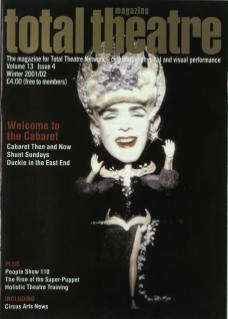‘Hello. I'm Lion. Roar. Welcome to Shunt Cabaret'. On three Sundays during the BAC's OctoberFest, around the corner from Bethnal Green tube station, tucked away and secretive, two damp and inauspicious railway arches played host to the 17th, 18th and 19th Shunt Cabaret.
Deliberately eccentric, these arches are a space soaked in innovation, experiment and off the wall silliness. Structured formally but going off under-rehearsed and ad hoc, the Shunt Cabaret hangs together through the sheer will power of its originators and the enthusiastic response of the filled to capacity audience.
Each week the line up was compered by a member of Shunt: week one saw a huge lion on a box with wheels careering about the stage with Lizzie Clachan inside talking to us through a loudhailer. Week two: a vampire, performed by Hannah Ringham, introduced the acts while sitting on her coffin; mugging, corpsing and baring her fangs. Week three had David Rosenberg introducing the acts in boots bolted to the top of a set of swing doors or from outside the back of the arches through a little window.
Designed with a keen eye for detail, from a wooden shack bar to an artfully designed toilet-cum-fortune-telling Zen den; from a huge on stage moustache one week and little fluffy clouds the next, the arches became a theatrical space buzzing with quirkiness and creativity. Consisting of such acts as... A performer telling us about the difficulty of being a man whilst chasing a fluffy rabbit connected to his boot by a length of wire. A graceful aerialist hanging from the ceiling glorying in her crinoline skirt as her partner swings past trying to show off his more beautiful tissue paper skirt. The ‘caged series' – a weekly foray into the theoretical worlds of Antonin Artaud and Heiner Muller, playing with light and voiceover, all presented with the use of a cage on wheels. A woman arguing with her tape-recorded voice about how best to write her suicide note. Three video screens showing a split perspective of two women's conflict between themselves.
Many of the acts work best as short jokes – by presenting a simple image or situation. All the acts are vignettes that support only the conceit they have established. For example, one act, pre-interval, sees a woman dressed in the robes of a barrister asking us one of those all-important life-challenging questions – 'Where is the toilet?'. With the aid of detailed maps she proceeds to direct us to the exact location of the nearest toilets. Simple, so for those Shunt virgins in the audience there is no doubt as to where to relieve themselves during the interval.
Hit or miss, all thirty acts are performed with a strong commitment to the material and always with a complicit nod of self-awareness to the audience who respond openly and expect the unexpected. Yet in this atmosphere of openness and acceptance not every act runs smoothly or with success. Some acts exploit this environment to the borders of its limitations; by presenting an idea with a strong opening, often the theme can be taken too far past its sell-by-date, thereby milking the scene for all it is worth and leaving the audience waiting for the piece to end and move on. This can be the downfall of a format where so much is on offer. Each piece must, in a sense, up the ante from the previous act or risk setting the pace back for an audience hungry for a rapid change of material. Always there is the danger when experimenting with quirky ideas or radical images that a piece can fail to sustain the dramatic world it has created and simply leaves the audience wondering what it was they just saw.
The beauty of Shunt Cabaret, however, is that it can parody itself by realising its own shortcomings and responding with wit; for example, by throwing a cartoon-style bomb onto the stage and pushing it towards the audience before sheepishly picking it up and shuffling off stage with it.
The essence of cabaret is alive and kicking in the depths of east London. Go and see for yourself.
See Shunt's website at www.shunt.co.uk

